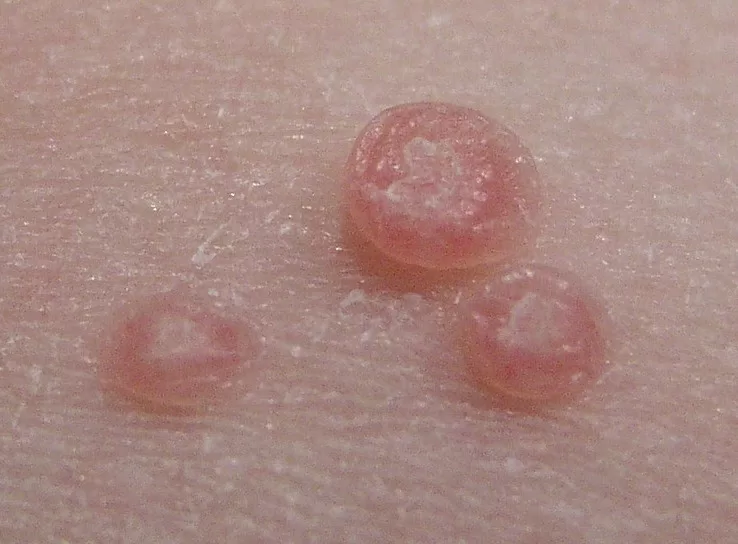- Home
- /
- HIV/STD
- /
- Common STDs
- /
- Molluscum contagiosum
Molluscum contagiosum is a viral infection of the skin or mucous membranes. The infection is caused by a DNA poxvirus called molluscum contagiosum virus (MCV). Because the virus does not use animals as hosts, only humans can be infected. MCV is divided into four types: MCV-1 to MCV-4; among them, MCV-1 is the most common; and MCV-2 is usually found in adults, and most of them are infected through sexual contact. This common virus has a higher incidence in children, sexually active adults, and those with compromised immune systems. In children, for example, infection is most common in the age group between one and ten years old. MCV can affect skin tissue anywhere on the body, but is most common on the trunk and extremities. Direct contact or sharing of personal items, such as clothing or towels, are the main routes of transmission for MCV.
Molluscum contagiosum is usually spread by skin-to-skin contact, including sexual contact, or touching the skin of another person with a limb that has touched or scratched a raised part of the skin. This virus can be transmitted from one part of the body to another part of the body, and can also be transmitted to other people. Children in day care centers or schools are one of the easiest places for the virus to spread. Molluscum contagiosum is extremely contagious and the infection will not stop until all raised areas of the skin have fully healed. If it is not dealt with in time, this situation may last for 6 months.
The time from being infected to the appearance of diseased tissue can be as long as 6 months, and the average incubation period is between 2 and 7 weeks.
Diagnostics
The diagnosis of infection must be confirmed by clinical signs, and the virus cannot be confirmed by inoculation. Although the diagnosis can be confirmed by excisional biopsy, this medical procedure is often unnecessary.
Symptoms
Molluscum contagiosum lesions are usually brightly colored, dome-shaped, and pearl-like in appearance. They usually vary in diameter from 1 mm to 5 mm and have a dimpled center. Although these lesions are not painful, they can be itchy for patients, which can make them very irritable. Scraping or scratching it could lead to further infection or scarring. About 10% of patients develop eczema around their diseased tissue. Scratching the diseased tissue can also cause bleeding. Viral infection is limited to the uppermost layer of the epidermis. Once the major portion of the virus containing the diseased tissue is destroyed, the infection is no longer present. Viruses reside in the central waxy core of diseased tissue. The virus may spread to adjacent skin tissue by a process called “self-inoculation”. Children are particularly vulnerable victims of the virus’s “self-inoculation” process, which spreads diseased tissue widely.
Individual molluscum contagiosum is usually confined to itself and will subside naturally. The infection period ranges from 6 weeks to 3 months. However, through the process of “self-inoculation”, an infected person infects himself again, so the disease may last longer. The average duration is from 8 months to about 18 months, and the disease may last anywhere from 6 months to 5 years.

Treatment
The way to treat molluscum contagiosum depends on the location and number of lesions. Generally, treatment is unnecessary for mild cases, and there is no single convincing method proven to be absolutely effective. Be aware that treatment may lead to further infection of tissue on or near the infected skin, much the same as scratching infected tissue. However, treatment may be given for the following reasons:
Medical factors:
- Bleeding
- Secondary infection
- Itching and discomfort
- Potential risk of scarring
- Chronic conjunctivitis
Social factors:
- Beauty
- embarrassed
- Fear of infecting others
- Rejected by others
Many medical experts recommend treating infected tissues located in the genital area to prevent them from spreading. The virus lives only in the skin, and when the infected tissue stops multiplying, the virus disappears, so it can no longer infect others. The infection is effectively cured when all infected tissue has been removed. Molluscum tissue will not reappear unless the patient is re-infected. In practice, it is not easy to be able to detect all molluscum contagiosum-infected tissues. Even when it seems like they’ve all disappeared, there’s always a chance some may have been missed. If so, the virus may reinfect patients through a process of “self-inoculation”, even though no infection is visible to the naked eye.
Cryotherapy
Cryotherapy involves killing infected cells by “freezing” them with a spray of pressurized liquid, liquid nitrogen or nitrous oxide being the most commonly used liquids. This medical procedure may cause mild discomfort to pain, depending on the amount of liquid spray required and the site of infection. This procedure can be performed by any healthcare professional. Applying liquid nitrogen to an infected area may cause the patient to experience a burning or tingling sensation that may persist for several minutes after the medical procedure is complete. Scarring or loss of skin color can complicate treatment. Liquid nitrogen can also cause blisters to form in the treated area, which usually fall off within two to four weeks. Cryotherapy and curettage are not painless medical procedures and may leave scars and/or permanently discolor the treated skin areas.
Over-the-counter medication
In mild cases of infection, over-the-counter wart medications, such as salicylic acid, may help shorten the duration of the infection. Daily topical application of retinoid cream “Retin-A 0.025%” may also trigger viral breakdown. These treatments generally take several months to clear up the infection, and these treatments are often accompanied by severe inflammation and discomfort.
Immunomodulators
Although the most appropriate doses of immunomodulators have yet to be determined, doctors still occasionally prescribe them. Immunomodulators are one type of immunotherapy. Immunotherapy primes the immune system to fight viruses that cause skin growths. Under normal circumstances, immunomodulators are used three times a week. After each use, the drug should stay on the skin for 6 to 10 hours, and then it should be washed off. The healing time varies from 4 to 16 weeks. Some small-scale studies point to an 80% success rate with such doses. There is another dosage regimen: three times a day for 5 days a week. Immunomodulators have not been approved by the Food and Drug Administration (FDA) as prescription drugs for the treatment of molluscum contagiosum. Only 1% immunomodulator ointment will be applied in this treatment regimen. At the same dose, but with a concentration higher than 1% in the ointment, it may cause chemical burns or potential nerve damage.
Laser
Pulsed dye laser therapy may be a better treatment option for patients who are seeking treatment and who have multiple tissue infections with molluscum contagiosum. Very good results have been documented for the treatment of molluscum contagiosum with a pulsed dye laser. The treatment was well tolerated, leaving no scarring or abnormal skin pigmentation. Infected tissue heals within two weeks without leaving any traces. Studies have shown that 96%-99% of diseased tissues can be cured with only one treatment procedure. Using a pulsed dye laser can solve the problem quickly and efficiently, however its high expense makes it less cost-effective than other options. Furthermore, not all clinics have such laser equipment.
Forecast
All molluscum tissue will clear up naturally within two years (usually within 9 months). As long as the diseased tissue is still growing, there is a possibility of infecting others. When growth stops, the virus cannot spread.
Molluscum contagiosum is different from herpes. Herpes can remain in an infected person in a dormant state for several years before reappearing in the person. Molluscum contagiosum does not stay in the body of an infected person, they only grow on the skin and do not reappear by themselves. Unfortunately, there are currently no permanent antibodies against the virus, so re-infection is possible when the skin is exposed to an infected person.
The benefit of treatment is that it speeds up the breakdown process of the virus. This limits the size of the “acne” scar. If left untreated, molluscum contagiosum can grow to the size of a pea or pea. Although the virus will decompose naturally, it will also leave a larger hole due to its growth. With so many treatment options available, the best time to treat molluscum contagiosum without leaving any marks on the skin is when the affected tissue is still small.
For inquiries, please contact
Tel : (852) 3160 4886
or Email : sexhealth@neohealth.com.hk


